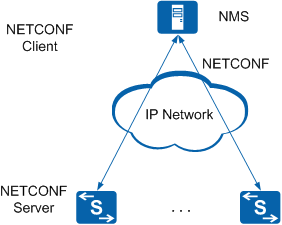NETCONF Working Mechanism
NETCONF Modes
- NETCONF over SSH Callhome: In this mode, the switch proactively sets up a NETCONF session with the NMS, which is Huawei's iMaster NCE-Campus.
- NETCONF over SSH: In this mode, the NMS, which is a third-party NMS, proactively sets up a NETCONF session with the switch.
NETCONF System Model
A NETCONF system uses the client-server model, as shown in Figure 1. The NMS uses the NETCONF protocol to configure and manage network devices.
NETCONF Protocol Architecture
Similar to the OSI model, NETCONF includes four layers, as described in Table 1.
Layer |
Content |
Description |
|---|---|---|
Content |
Configuration data, status data, statistics, notifications, etc. |
The Content layer contains a set of managed objects, such as configuration data, status data, statistics, and notifications. For the content that can be read by, written by, and reported to the NMS using NETCONF, see NETCONF YANG API Reference. |
Operations |
Databases, capabilities, and operations |
The Operations layer defines the databases, capabilities, and operations supported by NETCONF. For details, see Databases Supported by NETCONF and Capabilities and Operations Supported by NETCONF. |
Messages |
<rpc>, <rpc-reply>, and <notification> |
The Messages layer provides a simple remote procedure call (RPC) request and response mechanism independent of transport protocols, and a notification mechanism used by network devices to actively report alarms and events to the NMS.
|
Secure Transport |
SSH, SOAP, etc. |
The Secure Transport layer provides a communication path for interaction between the NMS and network devices. NETCONF can be layered over any transport protocol that meets the following basic requirements:
NOTE:
The switch supports only the SSH protocol as the transport protocol. |
